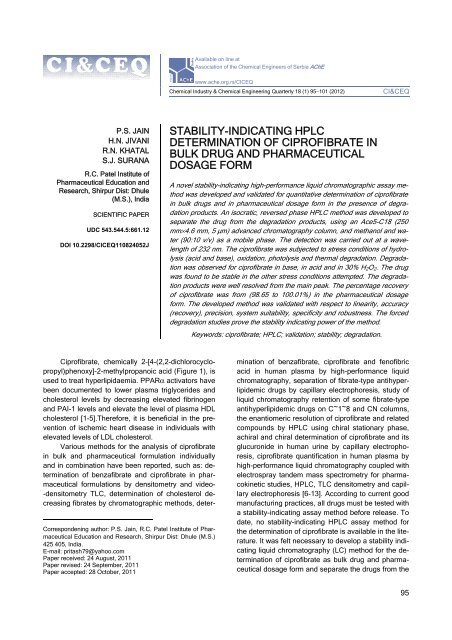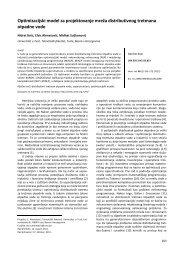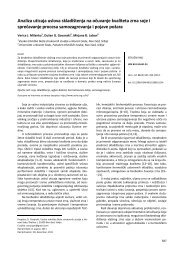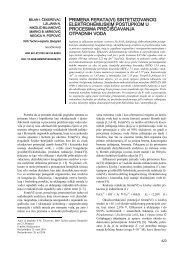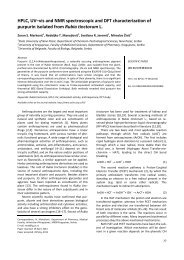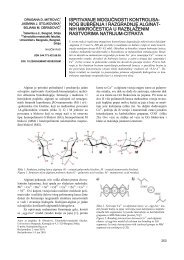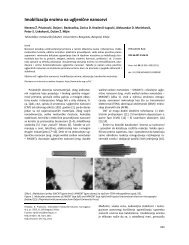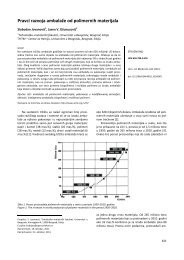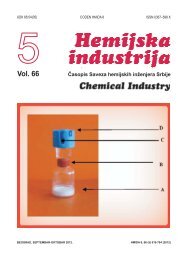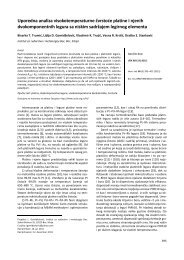stability-indicating hplc determination of ciprofibrate in ... - doiSerbia
stability-indicating hplc determination of ciprofibrate in ... - doiSerbia
stability-indicating hplc determination of ciprofibrate in ... - doiSerbia
You also want an ePaper? Increase the reach of your titles
YUMPU automatically turns print PDFs into web optimized ePapers that Google loves.
P.S. JAIN<br />
H.N. JIVANI<br />
R.N. KHATAL<br />
S.J. SURANA<br />
R.C. Patel Institute <strong>of</strong><br />
Pharmaceutical Education and<br />
Research, Shirpur Dist: Dhule<br />
(M.S.), India<br />
SCIENTIFIC PAPER<br />
UDC 543.544.5:661.12<br />
DOI 10.2298/CICEQ110824052J<br />
Cipr<strong>of</strong>ibrate, chemically 2-[4-(2,2-dichlorocyclopropyl)phenoxy]-2-methylpropanoic<br />
acid (Figure 1), is<br />
used to treat hyperlipidaemia. PPARα activators have<br />
been documented to lower plasma triglycerides and<br />
cholesterol levels by decreas<strong>in</strong>g elevated fibr<strong>in</strong>ogen<br />
and PAI-1 levels and elevate the level <strong>of</strong> plasma HDL<br />
cholesterol [1-5].Therefore, it is beneficial <strong>in</strong> the prevention<br />
<strong>of</strong> ischemic heart disease <strong>in</strong> <strong>in</strong>dividuals with<br />
elevated levels <strong>of</strong> LDL cholesterol.<br />
Various methods for the analysis <strong>of</strong> cipr<strong>of</strong>ibrate<br />
<strong>in</strong> bulk and pharmaceutical formulation <strong>in</strong>dividually<br />
and <strong>in</strong> comb<strong>in</strong>ation have been reported, such as: <strong>determ<strong>in</strong>ation</strong><br />
<strong>of</strong> benzafibrate and cipr<strong>of</strong>ibrate <strong>in</strong> pharmaceutical<br />
formulations by densitometry and video-<br />
-densitometry TLC, <strong>determ<strong>in</strong>ation</strong> <strong>of</strong> cholesterol decreas<strong>in</strong>g<br />
fibrates by chromatographic methods, deter-<br />
Corresponden<strong>in</strong>g author: P.S. Ja<strong>in</strong>, R.C. Patel Institute <strong>of</strong> Pharmaceutical<br />
Education and Research, Shirpur Dist: Dhule (M.S.)<br />
425 405, India.<br />
E-mail: pritash79@yahoo.com<br />
Paper received: 24 August, 2011<br />
Paper revised: 24 September, 2011<br />
Paper accepted: 28 October, 2011<br />
Available on l<strong>in</strong>e at<br />
Association <strong>of</strong> the Chemical Eng<strong>in</strong>eers <strong>of</strong> Serbia AChE<br />
www.ache.org.rs/CICEQ<br />
Chemical Industry & Chemical Eng<strong>in</strong>eer<strong>in</strong>g Quarterly 18 (1) 95−101 (2012) CI&CEQ<br />
STABILITY-INDICATING HPLC<br />
DETERMINATION OF CIPROFIBRATE IN<br />
BULK DRUG AND PHARMACEUTICAL<br />
DOSAGE FORM<br />
A novel <strong>stability</strong>-<strong><strong>in</strong>dicat<strong>in</strong>g</strong> high-performance liquid chromatographic assay method<br />
was developed and validated for quantitative <strong>determ<strong>in</strong>ation</strong> <strong>of</strong> cipr<strong>of</strong>ibrate<br />
<strong>in</strong> bulk drugs and <strong>in</strong> pharmaceutical dosage form <strong>in</strong> the presence <strong>of</strong> degradation<br />
products. An isocratic, reversed phase HPLC method was developed to<br />
separate the drug from the degradation products, us<strong>in</strong>g an Ace5-C18 (250<br />
mm×4.6 mm, 5 μm) advanced chromatography column, and methanol and water<br />
(90:10 v/v) as a mobile phase. The detection was carried out at a wavelength<br />
<strong>of</strong> 232 nm. The cipr<strong>of</strong>ibrate was subjected to stress conditions <strong>of</strong> hydrolysis<br />
(acid and base), oxidation, photolysis and thermal degradation. Degradation<br />
was observed for cipr<strong>of</strong>ibrate <strong>in</strong> base, <strong>in</strong> acid and <strong>in</strong> 30% H2O2. The drug<br />
was found to be stable <strong>in</strong> the other stress conditions attempted. The degradation<br />
products were well resolved from the ma<strong>in</strong> peak. The percentage recovery<br />
<strong>of</strong> cipr<strong>of</strong>ibrate was from (98.65 to 100.01%) <strong>in</strong> the pharmaceutical dosage<br />
form. The developed method was validated with respect to l<strong>in</strong>earity, accuracy<br />
(recovery), precision, system suitability, specificity and robustness. The forced<br />
degradation studies prove the <strong>stability</strong> <strong><strong>in</strong>dicat<strong>in</strong>g</strong> power <strong>of</strong> the method.<br />
Keywords: cipr<strong>of</strong>ibrate; HPLC; validation; <strong>stability</strong>; degradation.<br />
m<strong>in</strong>ation <strong>of</strong> benzafibrate, cipr<strong>of</strong>ibrate and fen<strong>of</strong>ibric<br />
acid <strong>in</strong> human plasma by high-performance liquid<br />
chromatography, separation <strong>of</strong> fibrate-type antihyperlipidemic<br />
drugs by capillary electrophoresis, study <strong>of</strong><br />
liquid chromatography retention <strong>of</strong> some fibrate-type<br />
antihyperlipidemic drugs on C~1~8 and CN columns,<br />
the enantiomeric resolution <strong>of</strong> cipr<strong>of</strong>ibrate and related<br />
compounds by HPLC us<strong>in</strong>g chiral stationary phase,<br />
achiral and chiral <strong>determ<strong>in</strong>ation</strong> <strong>of</strong> cipr<strong>of</strong>ibrate and its<br />
glucuronide <strong>in</strong> human ur<strong>in</strong>e by capillary electrophoresis,<br />
cipr<strong>of</strong>ibrate quantification <strong>in</strong> human plasma by<br />
high-performance liquid chromatography coupled with<br />
electrospray tandem mass spectrometry for pharmacok<strong>in</strong>etic<br />
studies, HPLC, TLC densitometry and capillary<br />
electrophoresis [6-13]. Accord<strong>in</strong>g to current good<br />
manufactur<strong>in</strong>g practices, all drugs must be tested with<br />
a <strong>stability</strong>-<strong><strong>in</strong>dicat<strong>in</strong>g</strong> assay method before release. To<br />
date, no <strong>stability</strong>-<strong><strong>in</strong>dicat<strong>in</strong>g</strong> HPLC assay method for<br />
the <strong>determ<strong>in</strong>ation</strong> <strong>of</strong> cipr<strong>of</strong>ibrate is available <strong>in</strong> the literature.<br />
It was felt necessary to develop a <strong>stability</strong> <strong><strong>in</strong>dicat<strong>in</strong>g</strong><br />
liquid chromatography (LC) method for the <strong>determ<strong>in</strong>ation</strong><br />
<strong>of</strong> cipr<strong>of</strong>ibrate as bulk drug and pharmaceutical<br />
dosage form and separate the drugs from the<br />
95
P.S. JAIN et al.: STABILITY-INDICATING HPLC DETERMINATION OF CIPROFIBRATE… CI&CEQ 18 (1) 95−101 (2012)<br />
degradation products under the International Conference<br />
on Harmonization (ICH) suggested conditions<br />
(hydrolysis, oxidations, photolysis and thermal stress)<br />
[14,15]. Therefore, the aim <strong>of</strong> the present study was<br />
to develop and validate a <strong>stability</strong>-<strong><strong>in</strong>dicat<strong>in</strong>g</strong> HPLC assay<br />
method for cipr<strong>of</strong>ibrate as bulk drug and <strong>in</strong> pharmaceutical<br />
dosage form as per ICH guidel<strong>in</strong>es [15].<br />
96<br />
Figure 1. Chemical structure <strong>of</strong> cipr<strong>of</strong>ibrate.<br />
EXPERIMENTAL<br />
Materials and reagents<br />
Cipr<strong>of</strong>ibrate bulk drug (purity 99.8%) and tablet<br />
cipr<strong>of</strong>ibrate (100 mg) were obta<strong>in</strong>ed from Glenmark<br />
Pharmaceuticals (Nasik, India). Hydrochloric acid and<br />
sodium hydroxide pellets were obta<strong>in</strong>ed from Rankem<br />
Laboratories India. Methanol and o-phosphoric acid<br />
were obta<strong>in</strong>ed from Merck Specialities Private Ltd.<br />
Hydrogen peroxide was obta<strong>in</strong>ed from Fischer Scientific,<br />
India. All chemicals used were <strong>of</strong> HPLC grade.<br />
Milli-QWater was used throughout the experiment.<br />
Chromatographic condition<br />
The HPLC system used was a Shimadzu system<br />
equipped with a photodiode array detector. A<br />
chromatographic column <strong>of</strong> 250 mm length and <strong>in</strong>ternal<br />
diameter <strong>of</strong> 4.6 mm filled with octadecyl silane<br />
Ace5-C18 (Advanced Chromatography Technology,<br />
USA) stationary phase with particle size 5 μm were<br />
used. The <strong>in</strong>strumental sett<strong>in</strong>g was at a flow rate <strong>of</strong> 1<br />
mL m<strong>in</strong> -1 . The <strong>in</strong>jection volume was 20 μL. The detection<br />
wavelength was 232 nm.<br />
Mobile phase<br />
The mobile phase consisted <strong>of</strong> methanol and<br />
water <strong>in</strong> the ratio 90:10 v/v. The pH 3.7 <strong>of</strong> mobile<br />
phase was adjusted with o-phosphoric acid <strong>in</strong> double<br />
distilled water. The mobile phase was premixed and<br />
filtered through a 0.45 μm nylon filter and degassed.<br />
Preparation <strong>of</strong> standard stock solutions<br />
All solutions were prepared on a weight basis<br />
and solution concentrations were also measured on<br />
weight basis to avoid the use <strong>of</strong> an <strong>in</strong>ternal standard.<br />
Standard solution <strong>of</strong> cipr<strong>of</strong>ibrate was prepared by dis-<br />
solv<strong>in</strong>g the drugs <strong>in</strong> the diluents and dilut<strong>in</strong>g them to<br />
the desired concentration. Diluent A was composed <strong>of</strong><br />
methanol and diluent B was composed <strong>of</strong> water <strong>in</strong> the<br />
ratios <strong>of</strong> 90:10 v/v. Approximately 5 mg <strong>of</strong> cipr<strong>of</strong>ibrate<br />
was accurately weighed, transferred <strong>in</strong> a 50 mL volumetric<br />
flask, dissolved and diluted to 50 mL with the<br />
diluent A. From these stock solutions, 2 mL <strong>of</strong> cipr<strong>of</strong>ibrate<br />
standard solution were transferred <strong>in</strong> a 10 mL<br />
volumetric flask and diluted with diluent B. This f<strong>in</strong>al<br />
solution conta<strong>in</strong>ed 20 μg mL -1 <strong>of</strong> cipr<strong>of</strong>ibrate.<br />
Sample solution (tablets)<br />
Ten tablets <strong>of</strong> cipr<strong>of</strong>ibrate (100 mg) were f<strong>in</strong>ely<br />
ground us<strong>in</strong>g agate mortar and pestle. The ground<br />
material, which was equivalent to 10 mg <strong>of</strong> the active<br />
pharmaceutical <strong>in</strong>gredient, was extracted <strong>in</strong>to diluent<br />
A <strong>in</strong> a 25 mL volumetric flask by vortex mix<strong>in</strong>g followed<br />
by ultrasonication. 2 mL <strong>of</strong> the solution was diluted<br />
to 40 mL with diluent B. The solution was filtered<br />
through a 0.45 μm nylon filter and an appropriate concentration<br />
<strong>of</strong> sample (20 μg mL -1 assay concentration)<br />
was prepared at the time <strong>of</strong> analysis.<br />
Procedure for forced degradation study<br />
Stability test<strong>in</strong>g is an important part <strong>of</strong> the process<br />
<strong>of</strong> drug product development. The purpose <strong>of</strong><br />
<strong>stability</strong> test<strong>in</strong>g is to provide evidence <strong>of</strong> how the<br />
quality <strong>of</strong> a drug substance or drug product varies<br />
with time under a variety <strong>of</strong> environmental conditions,<br />
for example temperature, humidity, and light and enables<br />
recommendation <strong>of</strong> storage conditions, retest<br />
periods, and shelf life to be established. The two ma<strong>in</strong><br />
aspects <strong>of</strong> drug product that play an important role <strong>in</strong><br />
shelf-life <strong>determ<strong>in</strong>ation</strong> are assay <strong>of</strong> the active drug<br />
and the degradation products generated dur<strong>in</strong>g <strong>stability</strong><br />
studies.<br />
Preparation <strong>of</strong> sample solution<br />
Acidic degradation. 5 mg <strong>of</strong> drug was dissolved<br />
<strong>in</strong> 5 mL <strong>of</strong> diluent A, and 50 mL <strong>of</strong> 3 M hydrochloric<br />
acid was added. The solution was kept for 1 h, after<br />
which 10 mL <strong>of</strong> solution was neutralized with 3 M sodium<br />
hydroxide. The solution was then diluted with diluent<br />
B to prepare a work<strong>in</strong>g solution <strong>of</strong> 20 μg mL -1<br />
(pH <strong>of</strong> solution was 2.3).<br />
Alkal<strong>in</strong>e degradation. 5 mg <strong>of</strong> drug was dissolved<br />
<strong>in</strong> 5 mL <strong>of</strong> diluent A, and 50 mL <strong>of</strong> 0.5 M sodium<br />
hydroxide was added. The solution was kept for<br />
1 h, after which 10 mL <strong>of</strong> solution was neutralized with<br />
0.5 M hydrochloric acid. The solution was then diluted<br />
with diluent B to prepare a work<strong>in</strong>g solution <strong>of</strong> 20 μg<br />
mL -1 (pH <strong>of</strong> solution was 14).<br />
Oxidative degradation. 5 mg <strong>of</strong> drug was dissolved<br />
<strong>in</strong> 5 mL <strong>of</strong> diluent A, and 50 mL <strong>of</strong> 30% H2O2
P.S. JAIN et al.: STABILITY-INDICATING HPLC DETERMINATION OF CIPROFIBRATE… CI&CEQ 18 (1) 95−101 (2012)<br />
was added. The solution was kept for 4 h. The solution<br />
was then diluted with diluent B to prepare a work<strong>in</strong>g<br />
solution <strong>of</strong> 20 μg mL -1 .<br />
Thermal degradation. 10 mg <strong>of</strong> drug was kept <strong>in</strong><br />
the hot air oven for 48 h at 100 °C. The work<strong>in</strong>g solution<br />
was then prepared us<strong>in</strong>g diluents A and B.<br />
Photodegradation. 10 mg <strong>of</strong> drug was exposed<br />
to the short wavelength (254 nm) and long wavelength<br />
(366 nm) UV light for 48 h. The work<strong>in</strong>g solution<br />
was then prepared us<strong>in</strong>g diluents A and B.<br />
Specificity<br />
Specificity is the ability <strong>of</strong> the method to unequivocally<br />
assess the analyte <strong>in</strong> the presence <strong>of</strong> components,<br />
which may be expected to be present. Typically,<br />
these might <strong>in</strong>clude degradation products, matrix,<br />
etc. [15]. The specificity study <strong>of</strong> the developed<br />
HPLC method for cipr<strong>of</strong>ibrate was carried out <strong>in</strong> the<br />
presence <strong>of</strong> its degradation products. Stress studies<br />
were performed for cipr<strong>of</strong>ibrate bulk drug to provide<br />
an <strong>in</strong>dication <strong>of</strong> the <strong>stability</strong> <strong><strong>in</strong>dicat<strong>in</strong>g</strong> property and<br />
specificity <strong>of</strong> the proposed method. Intentional degradation<br />
was attempted to stress conditions expos<strong>in</strong>g it<br />
to acid (3 M hydrochloric acid), alkali (0.5 M NaOH),<br />
hydrogen peroxide (30%), heat (100 °C) and UV light<br />
(254 and 366 nm wavelength) to evaluate the ability<br />
<strong>of</strong> the proposed method to separate cipr<strong>of</strong>ibrate from<br />
its degradation products. For the light and heat studies,<br />
the study period was 48 h, whereas the study<br />
period was 1 h for acid and base, and 4 h for oxidetion<br />
studies. Peak purity test<strong>in</strong>g for cipr<strong>of</strong>ibrate was<br />
done by us<strong>in</strong>g a PDA detector <strong>in</strong> stress samples.<br />
RESULTS AND DISCUSSION<br />
Optimization <strong>of</strong> chromatographic conditions<br />
The primary target <strong>in</strong> develop<strong>in</strong>g this <strong>stability</strong><br />
<strong><strong>in</strong>dicat<strong>in</strong>g</strong> HPLC method is to achieve the resolution<br />
between cipr<strong>of</strong>ibrate and its degradation products. To<br />
achieve the separation <strong>of</strong> degradation products we<br />
used a stationary phase C-18 and comb<strong>in</strong>ation <strong>of</strong> mobile<br />
phase methanol and water (90:10 v/v). The separation<br />
<strong>of</strong> the degradation product and cipr<strong>of</strong>ibrate was<br />
achieved on Ace5 octadecyl silane C-18 stationary<br />
phase and methanol and water (90:10 v/v) as a mobile<br />
phase. The tail<strong>in</strong>g factor obta<strong>in</strong>ed was less than<br />
two and retention time was about 3.3 m<strong>in</strong> for the ma<strong>in</strong><br />
peak, and less than 4 m<strong>in</strong> for the degradation products,<br />
which would reduce the total run time and<br />
ultimately <strong>in</strong>crease the productivity thus reduc<strong>in</strong>g the<br />
cost <strong>of</strong> analysis per sample. Forced degradation study<br />
showed the method is highly specific and entire degradation<br />
products were well resolved from the ma<strong>in</strong><br />
peak. The developed method was found to be specific<br />
and the method was validated as per <strong>in</strong>ternational<br />
guidel<strong>in</strong>es.<br />
Result <strong>of</strong> forced degradation experiments<br />
Degradation was not observed for cipr<strong>of</strong>ibrate<br />
samples dur<strong>in</strong>g stress conditions like heat, UV and<br />
light, but was observed <strong>in</strong> base, acid and oxidation<br />
studies. Cipr<strong>of</strong>ibrate was degraded <strong>in</strong> acid (Figure 2),<br />
base (Figure 3) and by oxidation (Figure 4) and formed<br />
polar impurities. The observed degradation <strong>of</strong><br />
cipr<strong>of</strong>ibrate was 7.54% <strong>in</strong> acidic conditions, 4.88% <strong>in</strong><br />
basic condition after 1 h, and 58.70% after 4 h under<br />
Figure 2. Chromatogram <strong>of</strong> cipr<strong>of</strong>ibrate <strong>in</strong> acid degradation (acid degraded product (2.4 m<strong>in</strong>) and cipr<strong>of</strong>ibrate (3.3 m<strong>in</strong>)).<br />
Concentration <strong>of</strong> cipr<strong>of</strong>ibrate <strong>in</strong>jected was 20 μg mL -1 .<br />
97
P.S. JAIN et al.: STABILITY-INDICATING HPLC DETERMINATION OF CIPROFIBRATE… CI&CEQ 18 (1) 95−101 (2012)<br />
oxidation conditions. Peak purity results greater than<br />
990 <strong>in</strong>dicate that the cipr<strong>of</strong>ibrate peak is homogeneous<br />
<strong>in</strong> all stress conditions tested. The unaffected<br />
assay <strong>of</strong> cipr<strong>of</strong>ibrate <strong>in</strong> the tablets confirms the <strong>stability</strong><br />
<strong><strong>in</strong>dicat<strong>in</strong>g</strong> power <strong>of</strong> the method (Table 1).<br />
Determ<strong>in</strong>ation <strong>of</strong> active <strong>in</strong>gredients <strong>in</strong> tablets<br />
The contents <strong>of</strong> drug <strong>in</strong> tablets were determ<strong>in</strong>ed<br />
by the proposed method us<strong>in</strong>g the calibration curve.<br />
98<br />
Figure 3. Chromatogram <strong>of</strong> cipr<strong>of</strong>ibrate <strong>in</strong> base degradation (base degraded product (2.4 m<strong>in</strong>) and cipr<strong>of</strong>ibrate(3.3 m<strong>in</strong>)).<br />
Figure 4. Chromatogram <strong>of</strong> cipr<strong>of</strong>ibrate <strong>in</strong> oxidative degradation (oxidative degraded product (2.4 m<strong>in</strong>) and cipr<strong>of</strong>ibrate (3.3 m<strong>in</strong>)).<br />
Table 1. Summary <strong>of</strong> forced degradation results<br />
Method validation<br />
Precision<br />
Method precision (<strong>in</strong>tra-day precision) was evaluated<br />
by carry<strong>in</strong>g out six <strong>in</strong>dependent assays <strong>of</strong> cipr<strong>of</strong>ibrate<br />
test samples aga<strong>in</strong>st a reference standard.<br />
The percentage <strong>of</strong> RSD <strong>of</strong> six assay values obta<strong>in</strong>ed<br />
was calculated. The <strong>in</strong>termediate precision (<strong>in</strong>ter-day<br />
precision) <strong>of</strong> the method was also evaluated us<strong>in</strong>g<br />
Stress conditions Time, h Assay <strong>of</strong> active substance Degradation, % Peak purity a<br />
Acid hydrolysis (3 mol L -1 HCl) 1 90.24 7.54 999<br />
Base hydrolysis (0.5 mol L -1 NaOH) 1 88.69 4.88 999<br />
Oxidation (30% H2O2) 4 40.08 58.70 999<br />
Thermal (100 °C) 48 99.88 No degradation 999<br />
Photo 48 99.65 No degradation 999<br />
a<br />
Peak purity values <strong>in</strong> the range <strong>of</strong> 990-1000 <strong>in</strong>dicate the homogenous peak [16]
P.S. JAIN et al.: STABILITY-INDICATING HPLC DETERMINATION OF CIPROFIBRATE… CI&CEQ 18 (1) 95−101 (2012)<br />
two different analysts, different HPLC systems and<br />
different days <strong>in</strong> the same laboratory (Table 2).<br />
Accuracy (recovery test)<br />
Accuracy <strong>of</strong> the method was studied by recovery<br />
experiments. The recovery experiments were performed<br />
by add<strong>in</strong>g known amounts <strong>of</strong> the drugs <strong>in</strong> the<br />
placebo. The recovery was performed at three levels,<br />
80, 100 and 120% <strong>of</strong> the label claim <strong>of</strong> the tablet (100<br />
mg <strong>of</strong> cipr<strong>of</strong>ibrate). The recovery samples were prepared<br />
<strong>in</strong> the aforementioned procedure, and then 5<br />
mL <strong>of</strong> cipr<strong>of</strong>ibrate solution were transferred <strong>in</strong>to a 50<br />
mL volumetric flask and diluted to volume with diluent<br />
B. Three samples were prepared for each recovery<br />
level. The solutions were then analyzed, and the percentage<br />
recoveries were calculated from the calibration<br />
curve. The recovery values for cipr<strong>of</strong>ibrate ranged<br />
from 98.65 to 100.01%. The average recoveries <strong>of</strong><br />
three levels for cipr<strong>of</strong>ibrate were 99.5% (Table 3).<br />
L<strong>in</strong>earity<br />
The l<strong>in</strong>earity <strong>of</strong> the response <strong>of</strong> the drug was<br />
verified at seven concentration levels, rang<strong>in</strong>g from<br />
10 to 150% <strong>of</strong> the targeted level (20 μg mL -1 ). Concentration<br />
standard solutions conta<strong>in</strong><strong>in</strong>g 2-30 μg mL -1<br />
Table 2. Result <strong>of</strong> precision <strong>of</strong> test method<br />
<strong>of</strong> cipr<strong>of</strong>ibrate <strong>in</strong> each l<strong>in</strong>earity level were prepared.<br />
L<strong>in</strong>earity solutions were <strong>in</strong>jected <strong>in</strong> triplicate. The calibration<br />
graphs were obta<strong>in</strong>ed by the plott<strong>in</strong>g peak<br />
area versus the concentration data and were treated<br />
by least-squares l<strong>in</strong>ear regression analysis. The<br />
equation <strong>of</strong> the calibration curve for cipr<strong>of</strong>ibrate obta<strong>in</strong>ed<br />
was y = 56747x + 15156, the calibration graphs<br />
were found to be l<strong>in</strong>ear <strong>in</strong> the aforementioned concentrations.<br />
The coefficient <strong>of</strong> <strong>determ<strong>in</strong>ation</strong> was 0.998<br />
(Table 4).<br />
Limit <strong>of</strong> detection and limit <strong>of</strong> quantification<br />
(LOD and LOQ)<br />
The limit <strong>of</strong> detection (LOD) and limit <strong>of</strong> quantification<br />
(LOQ) were determ<strong>in</strong>ed by calibration curve<br />
method. 11 Specific calibration curve was constructed<br />
us<strong>in</strong>g samples conta<strong>in</strong><strong>in</strong>g the analytes <strong>in</strong> the range <strong>of</strong><br />
LOD and LOQ. The LOD and LOQ for cipr<strong>of</strong>ibrate <strong>in</strong><br />
LC were 0.24 and 0.73 μg mL -1 , respectively. LOD<br />
and LOQ were calculated by us<strong>in</strong>g the follow<strong>in</strong>g<br />
equations:<br />
LOD = 3.3Sa/b<br />
LOQ = 10Sa/b<br />
Sample number<br />
Assay <strong>of</strong> cipr<strong>of</strong>ibrate as % <strong>of</strong> labeled amount<br />
Analyst 1 (<strong>in</strong>tra-day precision) Analyst 2 (<strong>in</strong>ter-day precision)<br />
1 99.97 99.75<br />
2 99.87 99.40<br />
3 99.98 99.23<br />
4 99.56 99.31<br />
5 99.45 99.43<br />
6 99.68 99.13<br />
Mean 99.75 99.45<br />
RSD 0.12 0.101<br />
Table 3. Results <strong>of</strong> recovery tests <strong>of</strong> cipr<strong>of</strong>ibrate<br />
Level <strong>of</strong> addition, % Amount added, μg Recovery, % Average recovery, %<br />
80 4.8 98.65 99.5<br />
100 6 100.01<br />
120 7.2 99.84<br />
Table 4. L<strong>in</strong>earity study <strong>of</strong> cipr<strong>of</strong>ibrate<br />
Ser. no. Concentration, µg/ml Mean peak area ± SD (n = 6) RSD / %<br />
1 2 275833±3445.87 1.24<br />
2 4 365974±4217.05 1.15<br />
3 6 491417±5656.12 1.15<br />
4 8 604837±5995.67 0.99<br />
5 10 718773±10348.2 1.43<br />
6 12 835922±5788.57 0.69<br />
99
P.S. JAIN et al.: STABILITY-INDICATING HPLC DETERMINATION OF CIPROFIBRATE… CI&CEQ 18 (1) 95−101 (2012)<br />
where Sa is the standard deviation <strong>of</strong> the calibration<br />
curve and b is the slope <strong>of</strong> the calibration curve. Precision<br />
at limit <strong>of</strong> quantification and limit <strong>of</strong> detection<br />
was checked by analyz<strong>in</strong>g six test solutions prepared<br />
at LOQ and LOD levels and calculat<strong>in</strong>g the percentage<br />
RSD <strong>of</strong> area.<br />
Robustness<br />
In order to determ<strong>in</strong>e the robustness <strong>of</strong> the developed<br />
method, experimental conditions were purposely<br />
altered and the resolution between cipr<strong>of</strong>ibrate<br />
and acid degradation products was evaluated. The<br />
flow rate <strong>of</strong> the mobile phase was 1.0 mL m<strong>in</strong> -1 . To<br />
study the effect <strong>of</strong> flow rate on the resolution, it was<br />
changed by 0.2 units from 0.8 to 1.2 mL m<strong>in</strong> -1 . The effect<br />
<strong>of</strong> percent organic strength on resolution was<br />
studied by vary<strong>in</strong>g methanol from –10 to +10%. The<br />
resolution <strong>in</strong> the robustness study was not less than<br />
3.5 <strong>in</strong> all conditions. The <strong>stability</strong> <strong>of</strong> the standard solutions<br />
and the sample solutions was tested at <strong>in</strong>tervals<br />
<strong>of</strong> 24, 48 and 72 h. The <strong>stability</strong> <strong>of</strong> solutions was<br />
determ<strong>in</strong>ed by compar<strong>in</strong>g results <strong>of</strong> the assay <strong>of</strong> the<br />
freshly prepared standard solutions. The RSD for the<br />
assay results determ<strong>in</strong>ed up to 72 h for cipr<strong>of</strong>ibrate<br />
was 0.53%. The assay values were with<strong>in</strong> 1.5% after<br />
72 h. The results <strong>in</strong>dicate that the solutions were<br />
stable for 72 h at ambient temperature.<br />
CONCLUSIONS<br />
The developed method is <strong>stability</strong>-<strong><strong>in</strong>dicat<strong>in</strong>g</strong> and<br />
can be used for assess<strong>in</strong>g the <strong>stability</strong> <strong>of</strong> cipr<strong>of</strong>ibrate<br />
bulk drugs and pharmaceutical dosage form. The developed<br />
method is specific, selective, robust, rugged<br />
and precise. This method can be conveniently used<br />
for assess<strong>in</strong>g <strong>stability</strong> assay <strong>of</strong> selected substances<br />
and dissolution <strong>of</strong> tablets conta<strong>in</strong><strong>in</strong>g cipr<strong>of</strong>ibrate <strong>in</strong><br />
quality control laboratory. The study showed that the<br />
drug was stable for thermal and photo degradation<br />
conditions, whereas moderately degraded <strong>in</strong> acid<br />
(7.54%) and base (4.88%) conditions but highly degraded<br />
<strong>in</strong> the oxidative (58.70%) conditions.<br />
100<br />
Acknowledgements<br />
The authors are thankful to the Pr<strong>in</strong>cipal, R.C.<br />
Patel Institute <strong>of</strong> Pharmaceutical Education and Research,<br />
Shirpur - 425405 (MS), India, for provid<strong>in</strong>g the<br />
laboratory facility.<br />
REFERENCES<br />
[1] Mart<strong>in</strong>dale, The Complete drug reference, 35 th ed.,<br />
Council <strong>of</strong> Royal Pharmaceutical Society <strong>of</strong> Great Brita<strong>in</strong><br />
(2007) 1118<br />
[2] S. Budavari, The Merck Index, 14 th ed., Merck and Co.<br />
Inc., White House station, NJ, USA (1996) 386<br />
[3] Goodman and Gilmans, The Pharmacological Basis <strong>of</strong><br />
Therapeutics, 10 th ed., McGraw-Hill Publisher, New York<br />
(2003) 971<br />
[4] British Pharmacopoeia, The Stationary Office Medic<strong>in</strong>al<br />
and Pharmaceutical Substances, Vol-I (2005) 106-108<br />
[5] E.G.B. Bighetti, P.R. Patricio, A.C. Casquero, J.A. Berti,<br />
H.C.F. Oliveira, Lipids Health Dis. 50(8) (2009) 1-5<br />
[6] G. Misztal, L. Komsta, J. Planar Chromatogr. 18(3)<br />
(2005) 188-193<br />
[7] E. Kubl<strong>in</strong>, B. Kaczmarska-Graczyk, E. Malanowicz, A. P.<br />
Mazurek, Acta Pol. Pharmaceut. 67(5) (2010) 455-461<br />
[8] L.D. Masnatta, L.A. Cuniberti, R.H. Rey, J. Werba. J.<br />
Chromatogr., B. 687(2) (1996) 437-442<br />
[9] L. Komsta, G. Misztal, E. Majchrzak, A. Hauzer. J.<br />
Pharm. Biomed. Anal. 41(2) (2006) 408-414<br />
[10] G. Misztal, L. Komsta. J AOAC Int. 88(2) (2005) 479-489<br />
[11] N.H. Anderson, D. Johnston, P.R. Vojvodic, J. Pharm.<br />
Biomed. Anal. 10(7) (1992) 501-505<br />
[12] H. Huttemann, G. Blaschke. J. Chromatogr., B 729(1-2)<br />
(1999) 33-41<br />
[13] S. S<strong>in</strong>gh, M. Bakshi, J. Pharm. Biomed. Anal. 28 (2002)<br />
1011-1040<br />
[14] S. Baboota, S. Faiyaz, A. Ahuja, J. Ali, S. Shafiq, S.<br />
Ahmed. Acta Chromatogr. 18 (2007) 116-129<br />
[15] F.D. Mendes, L.S. Chend, A. Borgesd, T. Babadopulosd,<br />
J. O. Ilhad, K. M. Alkharfye, G.D. Mendesb, G. De<br />
Nuccie, J. Chromatogr., B 879(24) (2011) 2361-2368<br />
[16] V.K. Ahirrao, D.R. Sangale, V.S. Sonekar, V.V. Thorat, R.<br />
P. MArathe, R.B. Nawale, R.P. Pawar. Int. J. Ind. Chem.<br />
2(2) (2011) 69-77.
P.S. JAIN et al.: STABILITY-INDICATING HPLC DETERMINATION OF CIPROFIBRATE… CI&CEQ 18 (1) 95−101 (2012)<br />
P.S. JAIN<br />
H.N. JIVANI<br />
R.N. KHATAL<br />
S.J. SURANA<br />
R.C. Patel Institute <strong>of</strong> Pharmaceutical<br />
Education and Research, Shirpur Dist:<br />
Dhule (M.S.), India<br />
NAUČNI RAD<br />
PRIMENA HPLC METODE ZA ODREĐIVANJE<br />
STABILNOSTI CIPROFIBRATA U<br />
FARMACEUTSKOJ SUPSTANCI I<br />
FARMACEUTSKIM PREPARATIMA<br />
Razvijena je i validirana nova HPLC metoda za kvantitativno određivanje stabilnosti cipr<strong>of</strong>ibrata<br />
u farmaceutskoj supstanci i farmaceutskim preparatima u prisustvu degradacionih<br />
proizvoda. Za razdvajanje i određivanje aktivne supstance i degradacionih proizvoda<br />
korišćena je RP-HPLC metoda, sa kolonom Ace5-C18 (250 mm×4.6 mm, 5 μm) i<br />
mobilnom fazom metanol/voda u odnosu 90:10 v/v; komponente su detektovane na 232<br />
nm. Cipr<strong>of</strong>ibrat je podrvgnut kiseloj i alkalnoj hidrolizi, oksidaciji u 30% H2O2, fotolizi i<br />
degradaciji pri zagrevanju. Degradacioni proizvodi se dobro razdvajaju od glavnog pika<br />
aktivne susptance. Recovery vrednosti za farmaceutske formulacije su od 98.65 do<br />
100.01%. Razvijena metoda je validirana na l<strong>in</strong>earnost, tačnost (recovery), preciznost,<br />
proveru pogodnosti sistema, specifičnost i robustnost.<br />
Ključne reči: cipr<strong>of</strong>ibrat; HPLC; validacija; stabilnost; degradacija.<br />
101


